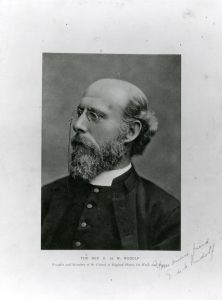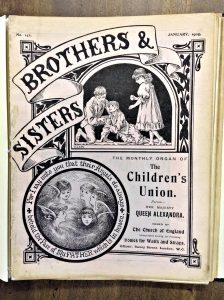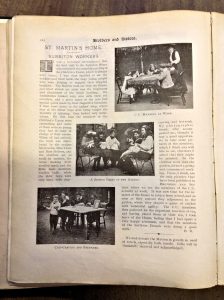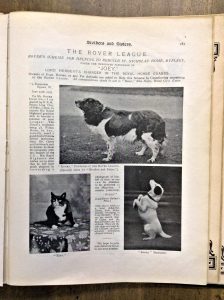Another in the series of blogs written by one of our volunteers, Rod Cooper, takes a look at The Children’s Society’s fundraising activity – here the work of the Children’s Union – a remarkable idea that allowed children to fundraise on behalf of children! The blog has two parts – this is part 1.
From a modern perspective it might appear unusual that an organisation established as recently as 1881 should, by 1889, be entertaining and indeed, actively, encouraging, the development of an additional movement within its ranks. But that’s exactly what happened when in 1889 the Church of England Central Society for Providing Homes of Waifs and Strays (henceforth, The Children’s Society) incorporated and adopted the fund-raising efforts and initiatives of The Children’s Union within its general organisation.
In light of this development, and notwithstanding the considerable zeal and organising talents of Edward Rudolf, it is evident that in its early days The Children’s Society was neither a ‘top down’ nor highly centralised organisation and considerable leeway was invested – and indeed, was essential for its success – in garnering the efforts, initiative and local knowledge of individuals and groups working within dioceses and parishes throughout England and Wales.
The Children’s Union developed out of such local efforts, and specifically the fund-raising activities of Miss Helen Milman. Miss Millman – who could not possibly have imagined what would develop from her quite simple idea – organised a fund-raising effort among the children in her town of Tenby, Pembrokeshire, with the specific goal of supporting a child at The Children’s Society’s recently opened St Nicholas’ Home for disabled children in Tooting, London. With the fund-raising being conducted during the children’s school holidays, the initiative quickly took on the name of the ‘Holiday Union’ and soon raised the £15 required to support one child for one year. Within two years, and attracting the interest and support of the Earl and Countess of Pembroke (also known as Lord and Lady Herbert), the scheme spread rapidly, to the extent that the fund-raising activities of children organised through a network of individual branches were soon able to wholly fund the St Nicholas Home.
Adopting the name Children’s Union in 1889, the C.U. was soon wholly or partly funding five homes belonging to The Children’s Society, all of which specialised in the care of disabled children; namely, St Nicholas’ (soon to be relocated to West Byfleet), St Martin’s at Surbiton, St Agnes’ at Croydon, St Chad’s at Leeds and Bradstock Lockett at Southport.
Specifically organised for the purpose of raising funds, membership of the C.U. was open (in 1905) to anyone under the age of 21, and at that year’s end was organised via a network of 444 branches with a membership of around 14,000. The monies raised in 1905 amounted to £5,536 7s. 10d. (i.e., just over £600,000 at present day values).
Based in parishes, schools and local communities in general, the branch network was in constant flux. In any single year, there would be a significant number of branches opening and closing. In 1905, for example, 38 branches started up, whilst 13 ‘lapsed’. To help bring the C.U. together there was a regular monthly magazine – Brothers and Sisters – and it is through the 1905 editions that I wish to explore and highlight the means by which the C.U. disseminated its message, promoted fund-raising schemes, and bonded its membership together.
Brothers and Sisters – 1905
Undoubtedly the patronage of the Earl and Countess of Pembroke was instrumental in spurring on the rapid development of the Children’s Union. January’s issue of Brothers and Sisters opens with an article penned by their daughter and President of the Children’s Union, Lady Beatrix Wilkinson, describing the Annual Sale at the Earl and Countess’ home at Wilton House in Wiltshire. Realising a profit of more than £100, the event comprised stalls selling “plain work, fancy work and articles, dolls, toys, sweets and teas,” and musical and theatrical performances, as well as a Baby Show. Sales of work and fêtes were a mainstay of branch fund-raising, but clearly this event was of a different order to those organised later in the year at, say, Lytham (raising £6 10s. 2d. – i.e., £6.51 approximately), or Keswick (£16 10s. – £16.50), and had a number of notable attendees such as their Royal Highnesses the Prince and Princess and Wales and the Duchess of Roxburghe.
Typical by this time, Brothers and Sisters would open with a short editorial piece, followed by news from its homes, with stories on the achievements of individual children and the growth and development of the homes themselves. In February’s issue, for example, there are articles – with accompanying photographs – on St Martin’s Home, Surbiton, and on the Bradstock Lockett Home, Southport. Without entirely using children’s full names (e.g., “Jim F.” and “Annie C. from Clitheroe”), the reports – without being patronising to the readership – clearly described the daily life, and sometimes the struggle, of the homes’ children. The articles take care too, to emphasise the value and impact of the fund-raising efforts of the Children’s Union and freely advertise any short-term causes and appeals. For example, the article regarding St Martin’s finishes with a request for clothing: “Will our readers ask any grown-up friends (fathers, brothers and uncles) for cast-off clothes, which will be gladly and thankfully received by our boys at Surbiton.”
As for the adult fundraisers of The Children’s Society, the Savings or Collections Box was an important means of collecting monies at the local level and in the March 1905 issue there was reference to this and myriad other locally inspired means of fund-raising. There was the following notice, for example: “The children of the Bryn Branch have done excellent work with their C.U. collecting boxes during the year. The members do not belong to the wealthy classes, and their small “self-denials” teach a lesson of earnest devotion to the cause for which they are so faithfully labouring.” Brothers and Sisters was careful to ensure that news of fund-raising efforts, whether large or small, were given equal space and prominence: for example, the Clyst Branch reported on “three entertainments” raising £3 11s. 4d. (about £3.57), and two performances of a children’s play at Pinner raising £1 1s. (£1.05).
The following month’s issue of Brothers and Sisters emphasises the direct relationship between Children’s Union members, their fund-raising endeavours and the children under the care of The Children’s Society. In an article reporting on the Bradstock Lockett Home, there is a List of Cots which identifies each individual child (or ‘cot’) alongside the branch supporting the cost of that child’s upkeep. By this means, a very direct and personal relationship was engendered between the branches, their members and the children in the homes. This strengthening of the bond would have been a powerful method of ensuring future interest in the welfare of individual children and the continued support from Children’s Union members.
Underlining the bond between Children’s Union members and individual children in the homes, there is short report under the May issue’s “Notes and Notices”. Headlined “Cot Friends” it states: “It very gratifying to note that, in response to the note in the last issue, some of the children in our Homes have found special friends in the C.U. who are going to write to them, and take personal and sympathetic interest in their welfare. We shall give every facility to those who desire to correspond with a child, and hope that a great measure of happiness may be the result of this friendly and sympathetic intercourse.”
As a further fund-raising initiative, to specifically help fund the re-building of the St Nicholas’ Home at Byfleet, the C.U. commenced promoting The Rover League in 1905 ; a means by which Children’s Union members and branches could enrol their pet dogs and submit funds on their pets’ behalf. By mid-year the scheme had blossomed and members were enrolling their various pets and submitting photographs for publication, typically accompanied by letters ‘penned’ by their pets. By June, “Rover’s Scheme for Helping to Re-build St. Nicholas’ Home, Byfleet” was under the “immediate patronage of “Joey” Lord Herbert’s Charger in the Royal Horse Guards”, and that month’s report commences, “Rover has got fifty-four new members during the month, including horses belonging to Lady Muriel Herbert (i.e., Lord Herbert’s younger daughter and Lady Beatrix Wilkinson’s sister), dogs, cats, a goat, some goldfish, and a delightful donkey.” Typical of the letters published in Brothers and Sisters is one from Sir Gibbie, a wire-haired fox terrier. Sir Gibbie sent 1s. 6d.; representing the membership fee of sixpence apiece for himself and his two friends, Daisy (“a grey donkey”) and Dick (“a sort of terrier”). By June it’s apparent that the specific purpose of the Rover League had broadened out somewhat, as a notice was included of a home wanted for “Emma” and “Eliza”, a pair of “mongrel lurcher puppies rescued from a cellar in East London”.
Part 2 to follow.
Want to know more?
Further information on the Children’s Union Rover League can be found on the Hidden Lives Revealed website: http://www.hiddenlives.org.uk/activities/rover_league/rover_league1.html
Scanned copies of the Brothers and Sisters magazine can be found here: http://www.hiddenlives.org.uk/publications/brothers_and_sisters/index.html
Records relating to the Children’s Union featured in this blog are held at The Children’s Society Archive:
- for information about The Children’s Society Archive’s ‘Hidden Lives Revealed’ web site: http://www.hiddenlives.org.uk/
- or you can consult the Archive’s on-line catalogue: http://www.calmview.eu/childrensociety/Calmview/
If you would would like to know about how The Children’s Society continues to change children’s lives today, visit the charity’s website: http://www.childrenssociety.org.uk/
© The Children’s Society





